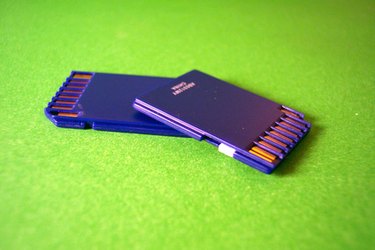
SD (Secure Digital) cards are commonly used in cameras, picture frames, music players and other electronic devices. They are solid-state memory, as opposed to a hard drive, which has moving parts. Lexar SD cards can be reliable, however they can sometimes run into problems: they can inadvertently become locked, restricting the addition of further data; they can become corrupted; and they can become full and needing emptying.
Step 1
Unlock the Lexar SD card if you are having problems writing to it. Take the card out of the device and, looking at the front of the card, you will see a tiny lock-switch on the left-hand side about three-quarters of the way up the SD card. Move the switch to the down position with your fingernail.
Video of the Day
Step 2
Reinsert the card in the device and try to add data. In a camera, this can be done by taking a photograph. Play the data back. In a camera, this could be by viewing the images. If either adding or playing data doesn't work, the card may have become corrupted.
Step 3
Insert the card in another device, say a camera or picture frame, and try to view the images. If you run into problems, the card is corrupted.
Step 4
Salvage the images that you can by copying them onto a computer hard drive or onto the internal memory of the device itself if there's enough space. Reformat the Lexar SD card, preferably in the device you plan to use the card most in. You will lose all the data on the card, but it will likely clear up any problems.
Video of the Day